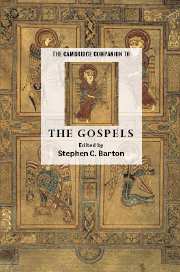Book contents
- Frontmatter
- Introduction
- Part I Approaching the gospels: context and method
- Part II The gospels as witnesses to Christ: content and interpretation
- Part III The afterlife of the gospels: impact on church and society
- 10 The gospels and the development of doctrine
- 11 The gospels embodied: the lives of saints and martyrs
- 12 Praying the gospels: spirituality and worship
- 13 Living the gospels: morality and politics
10 - The gospels and the development of doctrine
from Part III - The afterlife of the gospels: impact on church and society
Published online by Cambridge University Press: 28 January 2007
- Frontmatter
- Introduction
- Part I Approaching the gospels: context and method
- Part II The gospels as witnesses to Christ: content and interpretation
- Part III The afterlife of the gospels: impact on church and society
- 10 The gospels and the development of doctrine
- 11 The gospels embodied: the lives of saints and martyrs
- 12 Praying the gospels: spirituality and worship
- 13 Living the gospels: morality and politics
Summary
Before we examine what impact the gospels had on the development of doctrine, we need to explore the place of the gospels in the church in the first centuries. By the end of the second century an established pattern had clearly developed: the four gospels that we know as part of the New Testament canon were accepted as authoritative and read liturgically in most of the churches recognized by what would become the Christian mainstream. However, it is also clear that this was the result of some struggle over the issue, and that there were groups designated as heretical which preferred gospels other than the four we know, or fixed on one of the four, or sought to create one out of the four. Irenaeus, bishop of Lyon at the end of the second century, provides us with the arguments for the fourfold gospel and against other positions. Examining what he has to say, and what lay behind it, is instructive, if somewhat strange, to our ways of thinking. For Irenaeus, the fourfold gospel is providential, corresponding, first, to the fourfold nature of the created universe: there are four regions of the world and four winds (using the same Greek word as for 'breath' and 'spirit'), so, as the church is scattered all over the world and her 'pillar and ground' (1 Tim 3.15) is the gospel and the Spirit of life, it is fitting that she should have four pillars, breathing out immortality and reviving people in every place. Secondly, the fourfold gospel corresponds to the cherubim with four faces - the lion, the calf, the human, the eagle - each representing an aspect of the Logos (Word), namely, his kingship, his sacrifice, his first advent, and his gift of the Spirit. Irenaeus relates each gospel to one of these, so beginning a long tradition of artistic and exegetical symbolism. Finally he notes the four covenants given to the human race: with Adam, with Noah, with Moses, and the new covenant in Christ.
- Type
- Chapter
- Information
- The Cambridge Companion to the Gospels , pp. 203 - 223Publisher: Cambridge University PressPrint publication year: 2006

